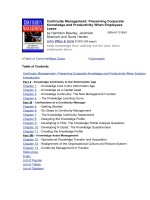John wiley sons e business and erp rapid implementation and project planning fly
Bạn đang xem bản rút gọn của tài liệu. Xem và tải ngay bản đầy đủ của tài liệu tại đây (1.61 MB, 293 trang )
TE
AM
FL
Y
Cover
Team-Fly®
Page i
E-BUSINESS AND ERP
Page ii
This page intentionally left blank.
Page iii
E-BUSINESS AND ERP
RAPID IMPLEMENTATION AND PROJECT PLANNING
MURRELL G. SHIELDS
Page iv
Copyright © 2001 by John Wiley & Sons, Inc. All rights reserved.
No part of this publication may be reproduced, stored in a retrieval system or transmitted in any
form or by any means, electronic, mechanical, photocopying, recording, scanning or otherwise,
except as permitted under Sections 107 or 108 of the 1976 United States Copyright Act, without
either the prior written permission of the Publisher, or authorization through payment of the
appropriate per -copy fee to the Copyright Clearance Center, 222 Rosewood Drive, Danvers, MA
01923, (978) 750-8400, fax (978) 750-4744. Requests to the Publisher for permission should be
addressed to the Permissions Department, John Wiley & Sons, Inc., 605 Third Avenue, New York,
NY 10158-0012, (212) 850-6011, fax (212) 850-6008, E-Mail:
This publication is designed to provide accurate and authoritative information in regard to the
subject matter covered. It is sold with the understanding that the publisher is not engaged in
rendering legal, accounting, or other professional services. If legal advice or other expert assistance
is required, the services of a competent professional person should be sought.
This title is also available in print as ISBN 0-471-40677-5 (cloth : alk. paper).
For more information about Wiley products, visit our web site at www.Wiley.com.
Page v
To my son, Robert, as he begins his own
career in systems development
Page vi
This page intentionally left blank.
Page vii
PREFACE
Organizations are going to have to change the way they implement packaged applications systems.
The old ways have never been successful and are incapable of supporting the needs of a rapidly
changing business economy. The e-business phenomenon has only accelerated the rate of these
changes and created more severe consequences from failing to implement solutions in a timely
manner. Organizations that want to be successful in the future are going to have to develop a core
competency in rapid implementation of packaged business applications to solve existing business
problems and take advantage of new opportunities in Internet time.
Organizations have been implementing computerized applications to support their business processes
for over 30 years. During the early years, most of these systems were custom developed: each
organization designed, programmed, tested, and implemented financial, human resource, and
operational systems to meet unique (or at least believed to be so) organizational requirements. Most
of these systems were developed by the organization's in-house information systems (IS)
department— with or without the help of consultants.
During the last 20 years, a whole industry has developed around the construction and marketing of
standard application packages: software that a vendor develops and sells to a wide variety of
organizations. With standard software, organizations do not have to create their own systems; they
can purchase and tailor the standard systems to meet their own needs, often in much less time than it
would take to develop these applications from scratch. Several of the packaged software vendors
have grown into large, global organizations.
The majority of the projects that have implemented these applications over the last 30 years have
been failures. They have taken much longer than planned, have cost many times more than originally
estimated, and have not produced the business results that were expected. Many of these projects
were aborted after years of effort and millions of dollars of cost. The primary reasons for these
failures are well documented and widely known. However, organizations continue to make the same
mistakes— and get the same results. This history of failures has created a bad image for business
system implementation projects.
Page viii
In the past, many of these system failures were masked from the view of organization's customers
and suppliers. Most of the applications that were implemented were back-office systems that did
basic transaction processing. These projects were usually done to reduce transactional costs and
mainly affected processing within the four walls of an organization. As such, they did not directly
touch an organization's customers and suppliers. Often managers and employees did not rely on
information in these systems to make decisions and provide accurate information to business
partners. A number of substitute processes and redundant data sources were used instead.
Because of significant changes in the last five years in the functional richness and variety of the
applications offered by the software vendors and the use of several new technologies in their
development (e.g., Internet protocols and standards, web servers, wireless communication, handheld
devices, graphical user interfaces, various middleware products), the potential business returns from
implementing these new applications have skyrocketed. The new applications can enable significant
changes in the way organizations perform business processes, share information with customers and
suppliers, and change business models and relationships.
Organizations are scurrying to take advantage of these new products and capabilities. The software
vendors and consulting organizations are all transforming themselves into e-business product and
service providers. New applications and uses of technology are surfacing every month.
These new applications go beyond the traditional applications available in the Enterprise Resource
Planning (ERP) suite of modules (e.g., financials, distribution, human resources, and manufacturing)
and extend to customer relationship management (CRM), supply chain management (SCM), eprocurement, data warehouses, and a multitude of new e-business enabling products (e.g., e-retailing,
e-mail management, and electronic marketplaces, exchanges, auctions). Organizations are not willing
to wait the normal one to three years it has taken to implement major systems in the past. To meet
rapidly changing business needs, organizations need to find ways to implement most or parts of these
new applications in a matter of months, not years.
This is where rapid implementation comes in. As with most things, there is good news and bad news
here.
The bad news is that projects that used to take years to complete now have to be done in a matter of
weeks and months. Not only that, but they have to be done successfully the first time. Solving critical
business problems quickly and taking advantage of opportunities resulting from the e-economy
makes implementation speed and time to market critical success factors. In this environment, in
many situations there is not time to fail and make a second attempt. The market will pass you by.
A second issue is the fact that most of the problems that plagued traditional implementations still
apply to rapid projects. So, in addition to figuring out how to do implementations faster, the teams
and their managers have to figure out how to avoid the problems that have caused these projects to
fail for the last 30 years.
Finally, the solutions that have to be implemented rapidly, avoiding traditional
Page ix
sources of failure, have to be better than those implemented in the past. In today's rapidly changing
business environment the solutions that are developed must be flexible and scale well. Business
situations are continuously changing. Mergers, acquisitions, changes in supply chain composition,
increasingly demanding customers, globalization, the Internet, and a number of other major trends
mean that any process design implemented today will probably be obsolete in a year or two.
Therefore, these designs (and the software that supports them) must meet current requirements and
be able to be adapted to a number of possible scenarios in the future.
Fortunately, there is good news to offset the bad. With the right implementation approach, vendor
package, accelerator tools, and management principles, it is possible to implement these products in
a third or less of the time that these projects have taken in the past. And this can be done in a way
that better manages the risks associated with these products. This is not idle speculation. There have
been hundreds of projects that have already proven the validity of this statement. But it does take a
different approach and the availability of a particular toolset to make all this happen.
That is what this book is about:
•Chapter 1 presents a case for making rapid implementations the preferred method for
approaching these projects.
•Chapter 2 describes the activities that are necessary to perform a rapid implementation.
•Chapter 3 covers three different approaches for selecting application packages that can be
implemented rapidly.
•Chapter 4 deals with the challenges of managing these projects.
•Chapter 5 discusses methods to address the people issues that have often been the primary source
of failure in the past.
•Chapter 6 describes what needs to be done to ensure that these projects are business driven and
deliver the business results that were used in justifying the project in the first place.
•Chapter 7 covers issues around supporting the IT aspects of these projects.
•Chapter 8 deals with tools, called accelerators, that must be present to support a rapid
implementation approach.
•Chapter 9 covers trends and changes in the business and the packaged software industry that will
impact implementations in the future.
•Chapter 10 gives guidance on what factors should be present before an organization is ready to
have a successful rapid-implementation project.
This book is based on my 20-plus years of experience implementing custom -developed and standard
package systems in various roles: project manager, process
Page x
team member, programmer and database administrator, steering committee member, functional
sponsor, information systems department manager, and end user. I have implemented many of the
major packages using traditional and rapid implementation methodologies and tools.
Most of the projects I have been involved with have required solving a multitude of problems that I
believe are an inherent part of managing and working on these initiatives. I have fought many hard
battles trying to successfully improve business processes through the implementation of enabling
technologies. There are a tremendous number of barriers that have to be overcome for that to happen.
TE
AM
FL
Y
My goal has always been to try to do each project better than the last. Therefore, I have continuously
experimented with approaches and tools— always looking for ways to make these projects more
successful. This book describes the lessons I have learned over the last 20 years and some key
insights that I believe will help others on the journey toward successful rapid implementation
projects.
Team-Fly®
Page xi
A CKNOWLEDGMENTS
There have been many people who have taught me a great deal about business, project management,
systems development, and consulting over the last 20 years. Those whom I have considered as
mentors on my professional journey have included Bob Anderson, Lee Marston, Dick Cardin, Scott
Wilson, Rita Valois, Mike Stipa, Tom Stadler, Bob Ruprecht, and David Edwards.
I want to thank Professor Bob West, of Villanova University, for encouraging me to write about
some of the lessons I have learned helping companies implement these systems. I also want to
express thanks to Sheck Cho, my editor at John Wiley & Sons, for encouraging and supporting me
through the publishing process.
My deepest gratitude goes to my wife Nancy, son Robert, and daughters Rebecca and Amy. They
serve as the motivation and inspiration for everything I do.
Page xii
This page intentionally left blank.
Page xiii
CONTENTS
Chapter 1 Why Most Implementations Should Be Rapid
But Are Not
1
Need for Speed
1
Custom Development (1960s and 1970s)
3
Standard Software (1970s and 1980s)
4
Application Suites (1990s)
6
ERP and E-Business (2000s)
7
Application Framework
10
Technology Infrastructure
11
Application Layers
12
Information Portals
16
Installation versus Implementation
17
How Fast Is Rapid?
20
Keys to Rapid Implementation
23
Chapter 2 Rapid Implementation Roadmap: What Is the
Implementation Process?
33
Commit
35
Start
39
Manage
42
Analyze
43
Configure
47
Test
48
Change
51
Page xiv
Support
54
Convert
56
Prepare
59
Go-Live
62
Improve
63
Chapter 3 Selecting the Right Package
67
General Package Characteristics
68
Vendor Criteria
71
Selection Approaches
73
Detailed Requirements Approach
74
Key Requirements Approach
77
Proof-of-Concept Approach
79
Selecting the Right Approach
81
Getting to a Short List of Packages
83
Due Diligence
86
Selection Team Members
88
Fast Selection Project Requirements
90
Chapter 4 Managing a Rapid Implementation
93
Business Case
94
Project Workplan
97
Status Reports
100
Scope Management
103
Time Boxing
107
80/20 Management
109
Templates and Deliverables
112
Risk Management
114
Issues Tracking and Resolution
118
Knowledge Management
121
Chapter 5 People Issues in Implementation
123
Importance of People Issues
124
Recruiting the Core Team
126
Post-Recruitment Activities
128
Project Team Organization
130
Page xv
Team Leadership Roles
131
Process Redesign and Support Roles
134
Use of Specialists
139
Rapid Implementation Change
142
Managing Change
143
Chapter 6 Making Implementations Business and
Process Driven
149
No Reengineering Allowed
151
Don't Pave the Cow Paths
153
Business-Driven Projects
155
Process Modeling
158
Vendor Process Models
161
Business Case Development
164
Package-Enabled Process Redesign
166
Process Redesign Goals
167
Staying Process Driven
173
Chapter 7 Technology Support Issues
177
IT Support Strategies
179
Technical Skill Challenge
180
Leveraging Vendors' IT Investments
183
Developing a Rapid Implementation Support
Capability
184
Setting Up the Team Technical Environment
185
Development Instances
188
Implementation Team IT Support Roles
191
Preparing for Production
195
IT Support After Cutover
197
Chapter 8 Project Accelerators
201
Rapid Implementation Methodologies
202
Process Models Mapped to the Package
205
Preconfigured Versions of the Package
208
Just-in-Time Training for the Project Team
210
Hosted Applications
213
User Procedure Manuals
216
Online Vendor Support
218
Page xvi
End-User Training Materials
220
Configuration Support
222
Automated Interfaces
225
Chapter 9 Trends and Implications
Consolidation of E-Business and ERP
Vendors
230
Moving Back to Best-of-Breed Applications
232
Increased Availability and Interest in
Outsourcing
235
Connecting Applications Across Enterprises
239
Wireless Technologies and Applications
242
Challenge of Internet Technologies
245
Consultant Capability Challenges
248
Increased Importance of Computer Security
252
Chapter 10 Conclusions and Final Thoughts
Index
229
255
Reasons for a Rapid Approach
255
Other Advantages
258
Trade-offs
259
Preconditions
261
Final Thoughts
262
265
Page xvii
E-BUSINESS AND ERP
Page xviii
TE
AM
FL
Y
This page intentionally left blank.
Team-Fly®
Page 1
1
WHY MOST I MPLEMENTATIONS SHOULD B E RAPID BUT
A RE N OT
There is a tremendous need for a different approach to implementing business computer applications.
Instead of large, full-scope projects, organizations should be doing a lot of smaller, focused projects.
Historically it has taken many months, and even years, to complete these implementations. In the
future these projects will have to be done in a matter of weeks and months.
There are important business reasons why the old way of doing these projects will have to change.
Organizations are now in a business environment where their success will depend on their ability to
rapidly respond to changing business requirements. There are no alternatives to becoming better at
making quick changes. Business changes require changes in business processes and the systems that
support them. Therefore, organizations must learn how to rapidly implement new business
application systems.
This chapter lays the groundwork for the material that follows. We begin by making a case for rapid
implementations. Then, we establish a foundation for the types of applications that are being
implemented by looking at the journey that standard software has taken over the last 40 years and
describe an architectural framework for looking at the new applications. The chapter then examines
the difference between installing and implementing software. After that, we look at how fast is rapid.
The chapter closes by laying out the key success factors for rapid implementations.
NEED FOR SPEED
The way that organizations have traditionally implemented complex business applications has to
change. The old approaches are too slow, expensive, and unreliable. In an age of rapid, continuous
change brought about by the Internet, reengineering, and
Page 2
globalization, projects that take years before an organization starts receiving benefits are no longer
acceptable! Recent changes in business and technology have permanently raised the implementation
bar.
As a result, organizations need to find ways to speed up the implementation process to solve their
business problems and take advantage of new opportunities. With the availability of new tools and
resources for these projects, taking a rapid approach to the implementation of standard business
software is possible. For most situations, it is the preferred approach.
Business applications (e.g., accounts payable, order entry, manufacturing, payroll, shipping,
inventory management, loan processing, student registration, customer billing) support, and to a
certain extent determine, the way work gets done in organizations. In the past, midsize or larger
organizations typically took one to three years to implement suites of these applications. In most
cases the organization did not receive any benefits until the entire project had been completed and
the organization went live with new software and business processes. In the new economy,
organizations must figure out how to solve problems and get benefits from these systems in a matter
of weeks or months.
To achieve this goal requires a different way of looking at these projects. The desired results should
drive the solution. Instead of starting from how long these projects have taken in the past, we must
let business requirements determine how long they can take in the future. The key question should
be: How long can the organization take to change business processes and the systems that support
them in order to meet the increasing demands of the marketplace?
Once they know the target, organizations must get serious about figuring out how to get these
implementations done quicker— in the required time frames. Increasingly, parts of complex systems
will need to be implemented in two to six months in order to meet competitive pressures.
Fortunately, there are already many examples that prove that, with a different approach and new
tools, meeting these shorter time frames is possible.
The drivers for business change (and faster implementations) are everywhere. There are tremendous
changes occurring in the business (and nonbusiness) world as a result of new technologies, business
models, global interests, changing customer expectations, and competitive challenges.
As evidence of the magnitude of these changes, you have only to consider the number of new ebusinesses that have been created in the last three years. These companies cannot wait years to get
financial, operational, and human resource systems up and running. They need to quickly get
systems operational to take orders, ship goods, pay employees, and produce financial statements for
investors.
In addition, existing organizations are all scrambling to become e-businesses. New technology
enablers are forcing most of them to reevaluate their business models and relationships, change
organizational structures, and redesign business pro-
Page 3
cesses to be more responsive to the increasing demands of customers. Internet technologies are
creating many new possibilities.
No company can ignore the availability of new technologies that, perhaps for the first time, truly
support the redesign and implementation of new ways of doing business. The only question is how
they can take advantage of these new technologies. Most organizations have not been very successful
in doing this in the past; many have recently gone through painful implementations of new systems.
The good news is that there are now software packages (standard software) for enterprisewide and
external-facing applications that leverage the newer technologies. They support business processes
that we would not have dreamed of five years ago. With these packages, organizations will not have
to develop their computer applications from scratch in order to create some tremendous capabilities.
The bad news is that we are going to have to implement these new technologies in much shorter
timeframes than ever before. Organizations must figure out how to do successful rapid
implementations of new processes using these new packaged solutions.
CUSTOM DEVELOPMENT (1960s AND 1970s)
Before we go any further in our discussion of rapid implementation, we need to set the stage by
briefly examining how organizations have implemented these packages in the past. To do this right
we need to briefly look at the history of ERP, what is meant by ERP and e-business applications, the
reason for implementing them, and the distinction between installing and implementing standard
applications. We begin in this section with the early use of computer applications.
When computers first started to be widely used in a business setting, in the early 1960s, they were
used to automate simple, routine business tasks. Payroll was a natural place to start. The calculation
of payroll amounts (multiply hours worked times hourly rate and then subtract for taxes and
deductions) was not particularly complicated but had to be done many times every week or so— and
very accurately. The next areas to be automated were the financial applications: general ledger,
accounts payable, accounts receivable, and fixed assets. Because of these historical roots, many of
the IS departments in organizations historically reported to the controller or vice president of finance.
The computer excels at doing things very fast and doing them the same way every time. Those are
two things that we humans, no matter how hard we try, generally have problems doing. (That is
especially true when we are tired or do not feel particularly motivated.) Therefore, computer systems
were widely used to automate back-office functions.
These early business applications had to be programmed by people from the IS department, or by
external consultants. When a computer was purchased, it could not
Page 4
do anything of value for the organization until the IS department wrote some programs. So, every
company wrote its own general ledger, payroll, order entry, and billing systems. Unfortunately, IS
departments generally were not very successful in creating these systems. As a result, they often
gained a reputation for delivering systems that did not meet users' needs, cost twice as much as
planned, and were delivered late.
Developing business applications (or any other kind of computer program) is a complex task, one
that most organizations did poorly. There were reasons for this situation.
The first programmers were usually people from one of the functional departments who had to learn
programming on the job, with little training and supervision. It is a very complicated activity to
determine business requirements, design and code programs, determine layouts for data records, and
test all the things that should go right and could go wrong. These tasks are especially difficult when
the programmer is under a lot of pressure to get the application out quickly, which was always the
case because of the multiyear backlog of requests in the IS department.
Also, by today's standards, there were not a lot of good tools available to develop the first systems.
The first programmers did not have high-level programming languages, relational database
management systems, a lot of memory on the computer to work with, or easy ways for a program to
interact with the user's terminal. There were no graphical interfaces back then; it was even difficult to
program real-time dialogs with terminals using character-based interfaces.
To make matters worse, after only short discussions with several of the users and managers, the
programmers often disappeared into their cubicles to develop these new systems. This development
was often done at night when programmers could get time on the computer to compile their
programs. So, the development was done without a lot of further involvement from the people who
would ultimately use the system or its reports.
As a result, the requirements for the applications were often misunderstood by the programmer (who
probably did not have a business background and was guessing what the user wanted), the system
did not meet users' needs, and it was delivered late and over budget. Some things have not changed a
lot over the years.
STANDARD SOFTWARE (1970s AND 1980s)
Around the 1970s, some of the programmers and computer consultants started to wonder if there was
not a better way. Why was every company reinventing the wheel when it created business
applications? After all, is the general ledger or payroll application of one company that much
different from one needed by other companies? So, companies were started to create standard (or
packaged) software. This is soft-









